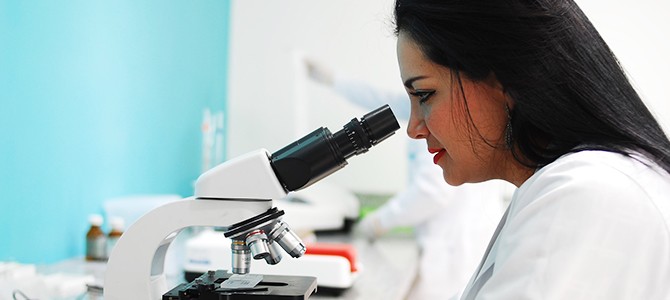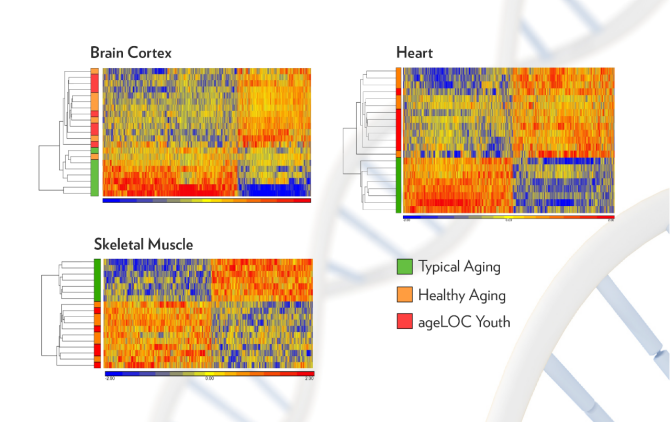Gene Expression - ageLOC Youth Innovation Background
December 09, 2020

Who would like to live young and live well? Be honest, raise your hand if this is you. There is a high demand for living young as you grow older, so scientists study ways to lessen some of the negative effects of aging. Most of us are seeing these effects as we speak! Think about what happens to your brain and memory as you age, or your energy levels, physical performance, heart health, and joint health, the list goes on and on. One well-established method of healthy aging, related to the intake of calories or how much food is consumed, has been shown in scientific research to have favorable outcomes on health. However, it is difficult and not practical to reduce the number of calories we consume for the rest of our lives. Therefore, one area of innovative research has focused on studying some of the mechanisms of this anti-aging intervention, and how certain nutrients may be able to provide similar benefits.
More and more research findings continue to validate the science behind ageLOC® Youth—our most advanced anti-aging supplement. A study published in the journal Nutrients in 2020, highlights innovative gene expression findings in multiple tissues. ageLOC Youth is a supplement that promotes the body’s natural ability to fight aging. Each ingredient, most of which are from foods not typically found in the everyday diet, were carefully selected for its unique health benefits and ability to positively impact gene expression. The result is a broad spectrum of anti-aging benefits that support many structures and functions in the body, such as cellular, brain, heart, metabolic, skin, bone and joint health.*
What is Gene Expression?
We used a proprietary gene expression screening tool to filter through a library of potential ingredients as we developed ageLOC Youth. But wait, what is gene expression you ask? Gene expression refers to how our genes behave in our cells. Cells in the body contain genetic material or information we call DNA; segments of this material are called genes. Genes share this genetic information with the cells or the body by being activated or expressed. Using gene chip technology, we are able to measure gene expression, which means we can measure how active a gene or multiple genes are. Some genes might have a high or low expression earlier in a person’s life and may even change with age. This is why we gain insight from comparing different biological states. We can compare how the same set of genes behaves differently between young and old individuals, as well as how our genes respond to a particular nutrient or even a blend of nutrients.
Based on our innovative gene expression approach, we discovered that certain ingredients showed positive impacts in one tissue but had little effect in another. Our research has shown that aging at the genetic level can vary and that there is no single ingredient that mimics the benefits of healthy aging in all tissues. However, we hypothesized that a blend of nutrients might work synergistically to support a healthier gene expression profile in multiple tissues.

Study Methods
After identifying a blend of ingredients, this blend was tested for its impact on gene expression in several tissues including the brain (cerebral cortex), skeletal muscle, and heart. Three groups were part of this study. The first group—”typical aging”—represented typical aging with no anti-aging intervention. The second group—”healthy aging”—represented aging with a well-established healthy aging intervention. The third group—“ageLOC Youth”—represented typical aging with ageLOC Youth supplementation.
Results
We used software to analyze gene expression data; this software clustered similar patterns of gene expression together, as represented by the heatmaps below. For each heatmap, the colors in the left-hand column denote which group each row belongs to. The Typical Aging rows (green) clustered together, whereas the Healthy Aging (orange) and ageLOC Youth groups (red) were interspersed and nearly indistinguishable.
In the brain cortex, skeletal muscle, and heart, the gene expression profiles of typical aging are distinctly different from those of healthy aging and ageLOC Youth, whereas the healthy aging and ageLOC Youth groups had similar gene expression patterns. This means that the ageLOC Youth group had a very different gene expression profile compared to typical aging. We know this is a good thing by comparing the data to a positive control, an intervention that we know is beneficial to aging. Because the ageLOC Youth and positive control groups are practically indistinguishable, this indicates that ageLOC Youth had a powerful impact on gene expression. And not just in one tissue: we measured gene expression in multiple tissues and found a positive effect in each one of these as seen below.

Conclusion
Our major finding was that a blend of ingredients comprising an innovative nutritional formula induces gene expression change in multiple tissues, like those induced by a well-established intervention of healthy aging. The results indicate that the benefits are achieved from the total blend of ingredients—not simply the contribution of one or two individual ingredients. The reference to the full study is found below and provides more details about this study for those who are interested. Please note that the findings in scientific studies are not product claims, rather they serve to further validate the science behind ageLOC Youth. For approved product claims, please consult official marketing materials.
Reference:
Serna, E.; Mastaloudis, A.; Martorell, P.; Wood, S.M.; Hester, S.N.; Bartlett, M.; Prolla, T.A.; Viña, J. A Novel Micronutrient Blend Mimics Calorie Restriction Transcriptomics in Multiple Tissues of Mice and Increases Lifespan and Mobility in C. elegans. Nutrients 2020, 12, 486.
*These statements have not been evaluated by the Food and Drug Administration. This product is not intended to diagnose, treat, cure, or prevent any disease.
-
Vitamin D is a unique vitamin that is synthesized by our body when our skin is exposed to sunlight. In fact, that’s where it gets the nickname, “the sunshine vitamin”. While we are theoretically able to get most of the vitamin D we need through sunlight, the reality is that for many of us, we don’t get enough. In fact, it is estimated that 88% of people globally have suboptimal vitamin D levels.
-
It has long been understood that the body utilizes electrical currents. This was first discovered by Luigi Galvani an Italian physicist who is said to initially have discovered animal electricity or bioelectricity. He identified that muscles in dead frog’s legs twitched when they encountered electrical sparks.

